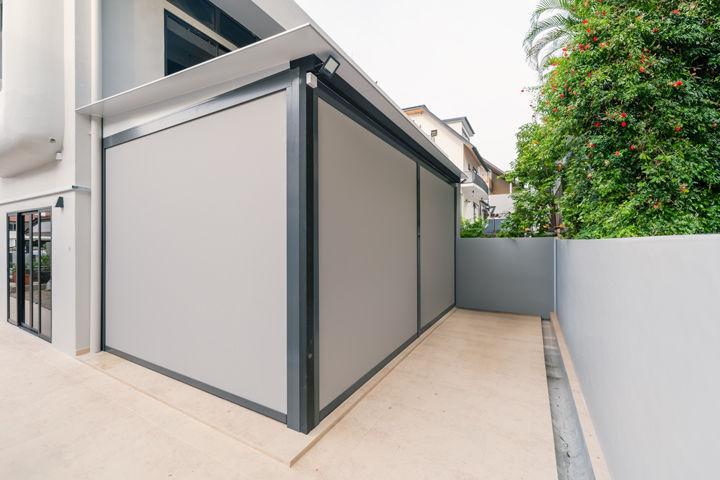Are Zip Track Blinds Really Waterproof? Here’s What You Need to Know
- ZipBlind

- Sep 19
- 4 min read
Updated: Sep 22

TL;DR
Zip track blinds are highly water-resistant, not watertight. Track-guided edges keep the fabric taut and divert rain, but they are not a sealed wall.
Performance = fabric + fit. Choose woven PVC with the right openness % (lower blocks more rain) and insist on precise, professional installation.
Real-world expectation. They keep spaces drier than older cable-guided blinds in daily weather; in wind-driven storms, a little floor-line water is still possible without a rainguard.
How zip track blinds keep rain out
Zip track blinds, also called zip blinds, use a zip track-guided system that traps the fabric within slim tracks and keeps it under tension. This track-guided approach eliminates the edge gaps that let water and wind through on loose outdoor roller blinds. A weighted bottom bar helps the screen meet the base cleanly, while a top pelmet shields the roll from direct rain and UV. The result is a tidy, taut surface that sheds water efficiently in typical showers and light winds, making outdoor areas such as balconies, patios and verandas usable more often.
“Waterproof” versus “water-resistant”
Marketing often mixes up “waterproof” and “water-resistant”. Zip track blinds do a great job keeping out rain, but they aren’t a sealed wall or window. In light to moderate rain, the tight fabric and side tracks keep out water well. In strong, wind-blown downpours, a fine mist can still get through tiny gaps in the fabric, and water can splash up from the floor. So expect strong everyday protection, but not a perfect seal in extreme weather. If you want more protection, ZipBlind offers 0% openness fabric that creates a continuous barrier to cut wind-blown mist. Add a rain guard and you can also stop floor splashback from entering your balcony.
Fabric choices and what they mean for rain protection
Choosing woven PVC fabric has a big impact on how well zip track blinds handle rain. Woven PVC is durable and water-resistant, so in steady showers it sheds water effectively, reduces glare and UV, and still allows airflow through the weave. In wind-blown downpours, a fine mist can pass through the tiny gaps, so you should expect strong everyday protection rather than a fully sealed rain wall.
To choose the right woven PVC, look at the fabric’s openness percentage. Lower openness blocks more rain and sun, while higher openness allows more breeze and keeps the view. Make sure the fabric has strong UV stability and protection against mould and mildew. Check that it holds its shape so the screen stays taut. Keep the fabric clean and correctly tensioned to maintain its rain performance and appearance. A trusted brand such as ZipBlind® will usually offer renowned fabrics like Phifer® Sheerweave, made in the USA.
Why installation matter
Even the best materials will not work well if the blind is installed poorly. A good installation starts with accurate measurements. The side tracks must be straight, the pelmet fitted neatly, and the fabric tension set so the screen sits tight against the edges. Small gaps at the sides or bottom are what let rain in, so an authorised, experienced installer will cut and align the parts to fit your opening closely and seal the screw points properly. In short, careful professional installation is the difference between the odd drip and a balcony that stays dry in normal rain.

How zip track blinds compare to other outdoor options
Traditional cable-guided outdoor roller blinds tend to leave small gaps where the panel meets the another panel or wall, and those openings are exactly where wind and rain sneak in. Zip track blinds eliminate these weak points by guiding the fabric within tracks and keeping it under controlled tension. That is why they usually outperform older styles for rain protection while maintaining a neater, more permanent look. They also offer stop-anywhere positioning, so you can lower the screen just enough to block glare while holding on to airflow and your view.
Setting realistic expectations
Think of zip track blinds as a versatile, weather-smart shield rather than a waterproof barrier in the absolute sense. In day-to-day conditions they make outdoor spaces feel like an extra room, cooler, drier and calmer, so you can work, dine or relax without rushing indoors at the first sign of drizzle. In torrential, wind-driven rain, they still help, but a little water on the floor line is possible, and closing the zip track blind down keeps the rain from coming in to damage your furniture.
The bottom line
Zip track blinds are among the most effective solutions for managing rain in open outdoor areas. Their track-guided design keeps the fabric taut, their fabric options let you tune the balance between rain block and airflow, and their performance holds up well with straightforward care. If you want to use your balcony or patio more hours of the day, in more kinds of weather, a well-specified zip track blind that is properly installed will get you most of the way to “waterproof” living without shutting the outdoors out.


